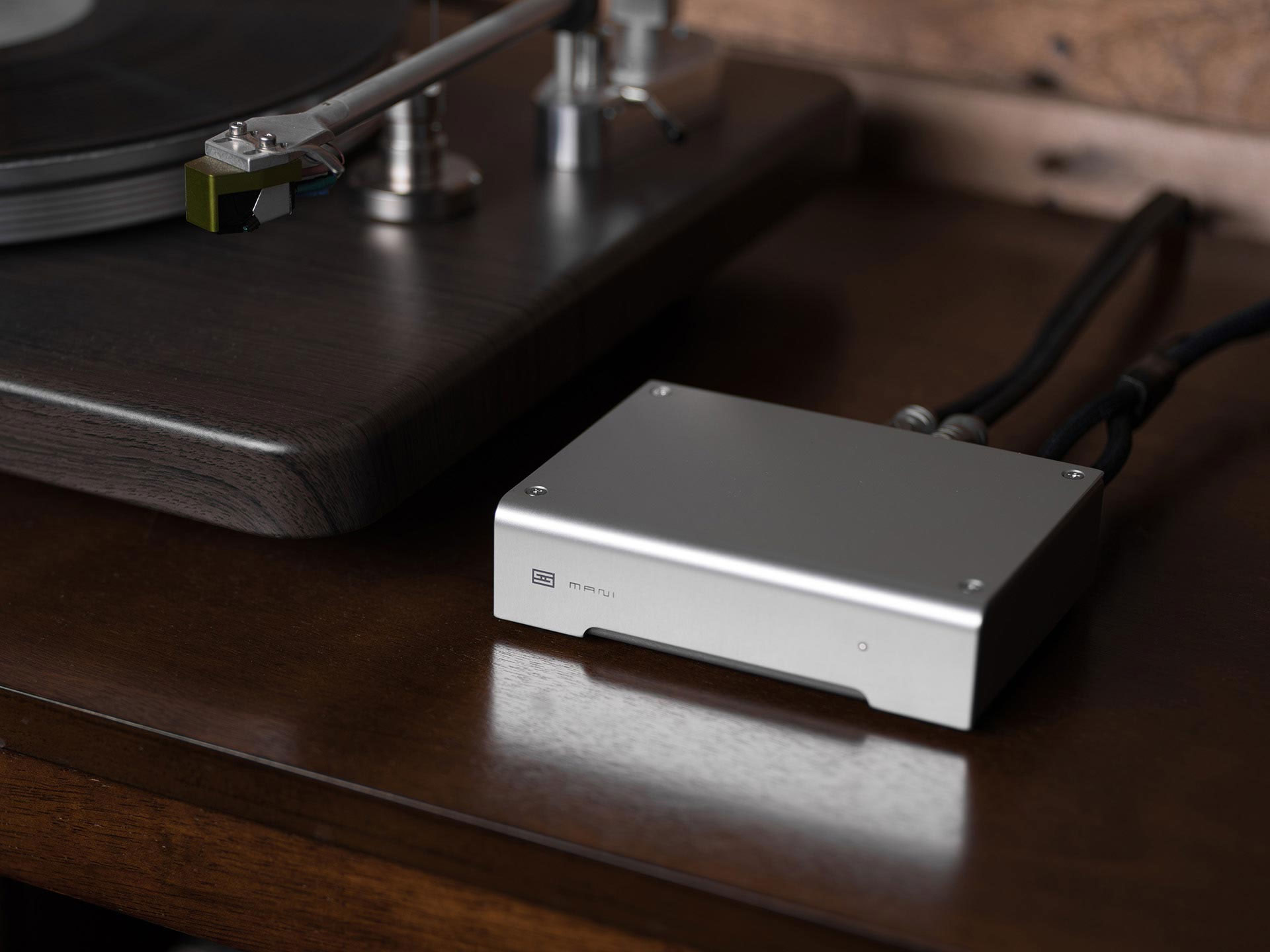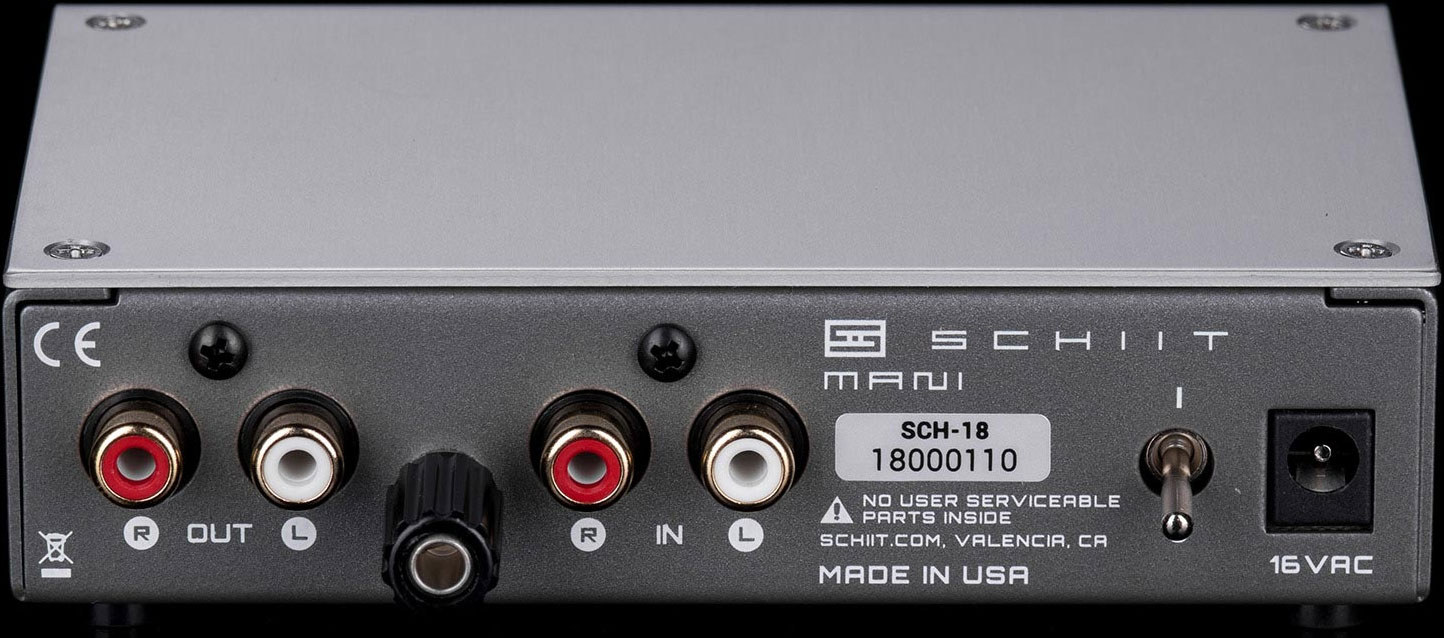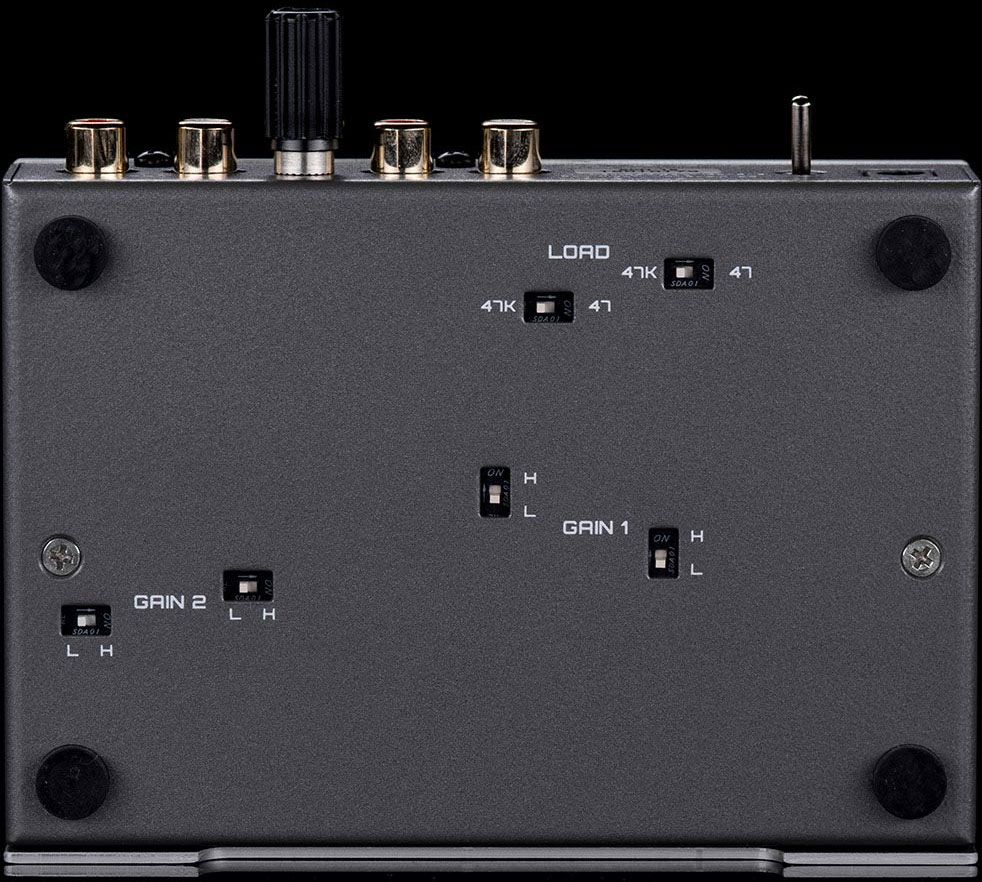An Antenna No More!
This past year numerous readers and followers of mine on Twitter and Facebook continually asked me to recommend a budget phono stage, and to this end I had acquired the following phono stages:
- Parasound ZPhono
- Cambridge Audio Duo
- NAD PP2e
- Musical Fidelity V90-LPS
- Rega Fono Mini
- Pro-Ject Audio Phono Box DC
That’s a lot of budget phono stages and, with six turntables and five separate systems here, I am just the staffer at Dagogo to pull this off. So, what’s the first thing you see that’s missing? That’s right … the Schiit Mani. Why did it not make the list? Because it failed one of the very first tests, which shocked me as it is so well regarded internationally, so well reviewed, and so loved by its owners.
A bit about the Schiit Mani: it is small and physically unassuming, so small that it fits nicely in my larger-than-life hands. To look at it, this exercise in minimalist design, from the front with its lone white LED power light it could be just about anything. But its underside tells a different story with its array of load and gain switches, making for a permutational host of settings. One could hardly ask for more and, given its design, asking for less would be a real challenge.
So, what was this test it failed and how was it so noticeable? Well, apart from all the others connected to all the same systems, in the same physical location (my home), the Schiit Mani was the only one to generate noise, and I’m not talking about music.
When I shared my thoughts with folks online about the outcome of my personal shoot-out, a good number of them were disappointed when I could not sing the praises of the Schiit Mani. It was not for lack of trying, as I had acquired one and then had to return it to the company for them to replace it with another, which did not produce, (1) a noticeable hum and, (2) enough RF interference for me to pick up a local AM Hispanic talk radio station, which could be heard through the static. Even with all of the Mani’s worldwide acclaim and with so many satisfied customers singing the phono stage’s praises, I knew I could not be the only one experiencing these issues. And while others and I represent a rather small minority, I could not personally recommend the product since, on my test bed, in my home, it simply did not function as advertised. Under my personal circumstances it was simply unacceptable.
I maintain a very strict policy regarding recommendations and reviews. Upon joining Dagogo, I laid out set of conditions, one of which was that I would not be pressured by the publication, manufacturers and/or public opinion to write anything that I could not personally stand behind.
To my great satisfaction, I learned this past week that Schiit has applied a new RF filter that eradicates the issues I encountered. Just yesterday (Saturday, March 16th) the updated Mani arrived in the post and I proceeded to run it through with all of my turntables and systems. It passed with flying colors. The sound of silence in the background is so welcome, and apart from Glenn Gould recordings, I can do without the hum.
Present Mani owners know how good the Mani can be, and for those who were put off by reports of the hum and RF interference, if you’re still in the market, I urge you to re-visit as I can, without equivocation, recommend the $129 Schiit Mani as an absolute bargain and able performer.
I am going to have to re-visit my shoot-out among the budget priced phono stages and see where the Schiit lands in the mix. The list at the beginning of this piece reflects the results in order of preference. I listened to all of them extensively, comfortable in the knowledge that the growing number of analogue audiophiles, who are just starting out are in good stead with the options at hand, are clearly not spoiled for choice. For our readers looking to eschew the pesky wall-wart, both the Parasound and Cambridge Audio units make use of internal power supplies and IEC power sockets.
Copy editor: Dan Rubin
- (Page 1 of 1)




I have never experienced “hum and RF interference” and my Schiit Mani which predates the “new RF filter” — which make me wonder if the good people at Schiit had made a change to the Mani along the way?
I purchased a Mani based on recommendations. I sold it at loss a couple of days later, the noise level was just obnoxious. A real piece of…
I eliminated my Mani humming with the $50 ifi Power 15 volt adapter. Now my Hana el sounds superb.
The schiit mani adapter voltage is 16 , isn’t any problem while using 15v power adapter?
Any chance you can include the Simaudio Moon $399 110lp v2?
never had any noise for a schiit mani
I did not experience any noise or humming with the Schiit Mani I bought. I’m satisfied.
I found the Ken post (March 21, 2019) interesting: “I eliminated my Mani humming with the $50 ifi Power 15 volt adapter. Now my Hana el sounds superb.”
The iFi 15 volt adaptor is 15VDC, while the Schiit Mani power adaptor is 16VAC.
However, in certain circumstances an AC adaptor can be replaced with a DC adaptor providing the device being powered is compatible with the lower overall voltage supplied by the DC adaptor. In this instance it appears the Schiit Mani is.
Let me digress a bit:
I have a Schiit Mani, and recently received a Hana ML low output moving coil. I set up the Mani for high gain operation, Gain Stages 1 and 2 to Hi. I then measured the Mani noise performance with my measurement system:
• Laptop connected to an external sound card via USB (192khz/24bit resolution) connected to the Mani RCA outputs (no input),
• TrueRTA software as a laptop-based spectrum analyser.
What I found was that the Mani experiences significant AC rectification harmonics on the RCA output connectors when in the Hi Gain mode, all the way up to 1Khz. The harmonics are present at around -75db on my test rig. The Left channel is most impacted with the Right channel about 6db lower.
I traced the issue to the bridge rectifier and associated filter capacitor (C1) with the high current AC rectification current spikes introducing EMI into the Gain Stage 1 OpAmps and associated components. Capacitor C1 lays horizontal on the circuit board with the Gain Stage 1 OpAmps laying directly below C1 on the other side of the circuit board.
My approach was to remove the bridge rectifier and install links to bypass it and power the Mani from a DC supply directly (24VDC). The output noise is now totally gone and the Mani sounds much better with low output moving coils (I also have a Supex 900e).
When I read Kens post above it triggered the thought: do I even need to remove the bridge rectifier?
The answer is probably no, not in the Mani case anyway. See the article in the link below to explain what happens when a DC supply is fed into a bridge rectifier:
https://www.quora.com/What-happens-when-a-dc-current-passed-through-a-bridge-rectifier
Based on the information contained in the link above I think the reason why a 15VDC source will work with the Mani is because of the Mani power supply design:
• The 16VAC is rectified by the bridge rectifier and generates a 23.5VDC supply with C1 as the filter capacitor (this is where the EMI current spikes are generated).
• The DC supply feeds a 12volt regulator (LM7812), with the 12VDC used as the clean voltage source by the following Mani power supply sections.
• The 12VDC feeds a DC Converter chip that generates +/-6VDC supplies (switching converter so a bit noisy).
• The +/-6VDC supplies feed +/-5V low voltage drop out regulators that power the OpAmps in the Mani and clean up the DC Converter noise.
This power supply seems complicated, but it does result in very clean DC supplies for the OpAmps (I would add the circuit diagram but don’t seem to be able to insert it into this post).
The reason a 15VDC supply operates with the Mani: – the 12V regulator (LM7812) has an input DC voltage range from 30VDC down to 14.5VDC to meet regulation spec at 1 amp current; so the 15VDC iPower power supply is just inside spec. The Mani only draws 80mA of current, so the lowest input DC voltage is probably less than 14.5v, and given the DC Converter chip that follows it possibly doesn’t matter if the voltage is lower. A DC supply anywhere from 15VDC up to 24VDC would work.
I would like to hear back from Ken on how his iPower 15VDC supply is holding up with the bridge Mani rectifier still in circuit. My modified Mani is going great.
This may be the best Schiit Mani hack ever for those using low output moving coils!! and certainly simpler than the path I had taken.
Please note, my experience with the AC rectification current spikes introducing harmonics into the Mani output means that upgrading to a different AC power supply will not address the issue I have found. Furthermore, the Mani power supply design as described above is very immune to the input power source, changing the AC source is unlikely to change the performance of the Mani.
A set of before and after spectrum plots for the Mani power supply harmonics can be found here:
https://www.stereo.net.au/forums/topic/236935-schiit-mani/
Yes, my iPower 15VDC power supply from ifi still works great with mu Hanna EL. Jason from Schiit has hinted that there will be a more advanced Phono preamp in 2020 as posted recently on head-fi. If it has impedance matching for mc cartridges and is under $200 I may pick it up.
Ken,
I am experiencing a moderate amount of EMI/RFI interference when I switched my receiver to Schitt Mani. I am thinking of buying the IFi 15VDC iPower based on your post above. Please let me know whether I can use the 15VDC iPower with the Schitt Mani without any modification to the Schitt Mani. Thanks.
When the ifi 15 v dc power supply arrived, I just substituted it for the AC 16 volt adapter from Schiit, no mods, just plug it in.
I will have to say that Schiit products suffer from close proximity to noisy sources. I installed an equipment rack and put my Prima Luna Prologue One integrated tube amp on the bottom shelf and Schiit Eitr, Bifrost 1 and mac mini (with Audirvana) on the middle shelf and turntable on top. Looked real neat but it sucked the life out of the digital music stream. I suspected this would happen from previous component moves so I moved the Tube amp to the floor between the speakers and used a schiit Sys with a 15 foot cable (maximum length recommended for Sys) to feed the amp from the Bifrost and the Mani. My setup has never sounded better.